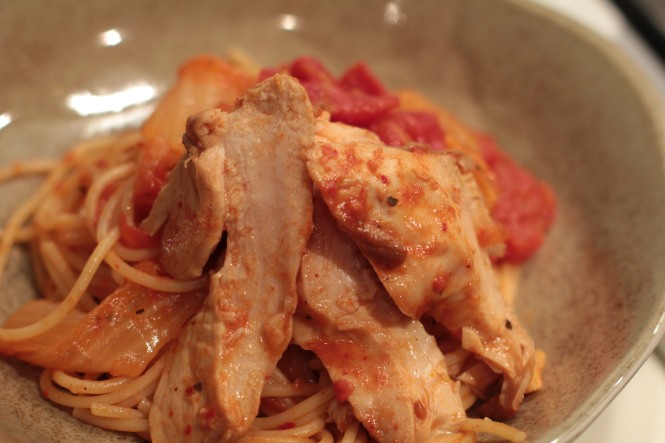低溫真空烹調的美好之處就是許多不討喜或難煮的部位都可以重獲新生. 雖說許多西方料理敬而遠之的部位在中菜裡是稀鬆平常的珍饈, 但我還是要來一探經典中菜經過低溫真空烹調的成果. 第一個要探索的就是 “滷”
之前已經常聽愛美麗吹噓老虎哥的滷牛腱. 我知道老虎哥曾經做過舞者打過籃球, 創過業還很容易跟麵店老闆變成好朋友. 我本來以為他拿手的老兵料理是這樣來的, 後來才知道原來老虎媽自己就是牛肉麵店的老闆. 有家學淵源的滷牛腱就成了這一次的主題:大同電鍋對上高科技電湯匙 (許多人在聽完低溫真空烹調的解釋後都會恍然大悟地替circulator下一個這樣的結論)
One beautiful thing about sous vide is that even cheap cuts are granted new life. And Chinese are, without doubt, one of the best in the world who know how to take full advantage of offals. I then march on to find out how some classic Taiwanese/Chinese recipes would behave in sous vide.
So I consulted Tiger. I know that Tiger’s been a dancer, an entrepreneur, even a basketball player. I also know that it’s extremely easy for him to become buddies with owners of noodle shops that he frequents. I thought maybe that’s why he’s so good at this type of cuisine. What I did not know was, Tiger’s mother runs a successful beef noodle shop. Mystery solved; it runs in the family.
I had heard Emily bragging about Tiger’s beef shin recipe for quite some time, and they were kind enough to invite me for a beef shin cook-off. Not exactly a cook-off actually since Tiger’s doing all the cooking; all I had to do is seal the pre-cooked beef in a vacuum bag and drop it in my sous vide bath. So it’s Tatung rice cooker/steamer vs sous vide.
For those who didn’t grow up with Tatung, here’s a brief introduction. Tatung is more than just a rice cooker; thousands of moms also serve beautiful stews, soups, steamed fish or spareribs out of it. It is also one things that a lot of Taiwanese students pack when they are about to set out for overseas studies. Well, it’s almost a culinary term for many in Taiwan.
準備/ Prepare
- 2 條牛腱 / 2 beef shins
- 8-10瓣的大蒜, 去皮稍微用刀背拍過備用 / 8-10 cloves of garlic. Remove the skin and beat roughly with the back of a knife.
- 3 支蔥, 切段 / 3 spring onions, cut into 5 cm
- 薑少許 (約20g), 去皮切段備用 / around 20g of ginger, peeled.
- 2 顆新鮮番茄切塊備用 / 2 fresh tomatoes, cut into wedges
- 米酒 250 cc / 250 cc of cooking rice wine
- 醬油 500 cc / 500 cc of fine soy sauce
- 冰糖一大匙 / 1 tablespoon rock sugar
- 雞粉三大匙 / 3 tablespoons chicken powder
- 滷包或是紅茶包一個 / 1 “chinese spice mix in a pouch” (you could often find it in Asian supermarkets. or feel free to substitute with one black tea bag.
- 將約三公升的水煮開. 在煮水的同時用叉子在牛腱上戳洞, 如此在燉煮的時候會比較入味.
- 水滾之後將牛腱下鍋煮約5-7分鐘, 然後濾除表面的雜質.
- 把蔥薑蒜和番茄下鍋一起煮.
- 等滾了之後再加入米酒, 醬油, 糖和滷包.
- 轉中火煮20分鐘後加入雞粉調味. 再煮20分鐘完成
- 大同電鍋版:將牛腱連湯汁放入大同電鍋中煮兩個半小時.
- 低溫烹調版:等溫度降到室溫以後放入冰箱隔夜冷卻. 冷卻之後封入真空袋, 用70度煮4個小時. 從水浴中拿起之後, 放入冰水中降溫, 然後在冰箱裡放12個小時以上, 讓醬汁繼續浸漬入味.
- Boil a pot of water (around 3 liters). While waiting, poke the beef shins with a fork to produce some holes. These holes will help sauce to penetrate the meat during cooking.
- After the water comes to a boil, add the beef shins. Let it cook for a good 5-7 minutes then skim the broth.
- Add all the garlic, ginger, spring onions and tomatoes in.
- After the mixture comes to a boil again, add in the rice wine, soy sauce, sugar and the spice mix.
- Turn the heat down to medium and cook for 20 minutes. Then season with chicken powder, medium heat for another 20 minutes.
- For the traditional method, the beef shin is moved into Tatung for 2.5 hours.
- For sous vide: wait until the pot is cool enough to be moved into the fridge, then chill it overnight before sealing the beef shins along with the broth in a vacuum bag. 70°C for 4 hours. Afterwards, chill the bag in an ice bath, then into the fridge for at least 12 hours so the meat could be marinated in the broth.














